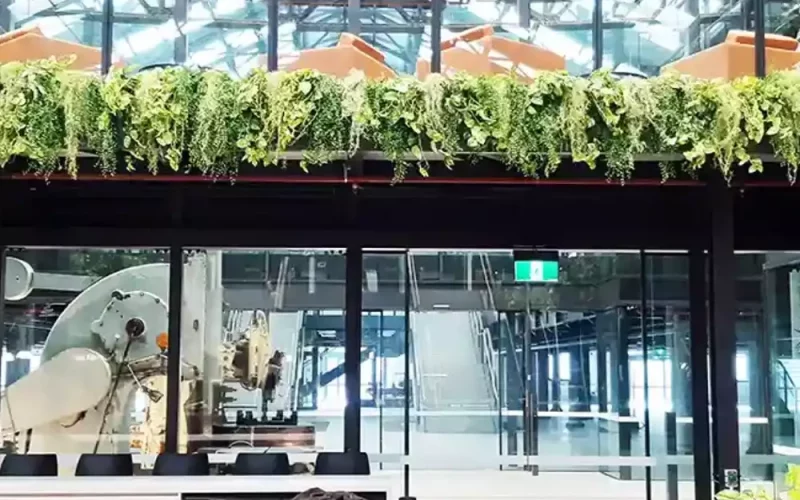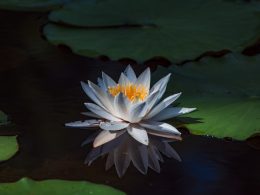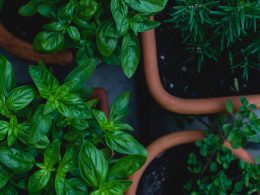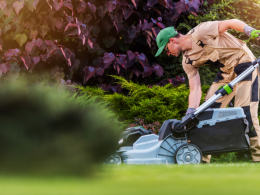Introduction
Indoor plants are more than just décor; they’re integral to improving air quality and creating healthier, more inviting workspaces. Whether you’re designing an office, hotel, or shopping centre, choosing the right location for your indoor hanging planters can make all the difference. Proper placement ensures that your plants thrive, contributing to a better environment while enhancing the aesthetics of your space.
At Ambius Australia, we understand the importance of optimising indoor plant placement for both visual appeal and air quality. In this guide, we’ll explore the best light for indoor plants, tips for indoor plant placement, and how to maximise the benefits of natural light for plants in your workspace.
Why the Right Light Matters for Indoor Plants
Indoor plants rely on light for photosynthesis, which helps them grow, absorb carbon dioxide, and release oxygen. This process is crucial for maintaining optimal indoor air quality and providing a sense of calm and well-being in your environment. However, not all plants need the same amount of light, and different types of lighting can have varying effects on plant health.
When it comes to indoor hanging planters, placement in the right light is essential for ensuring that plants grow strong and vibrant. Too much direct sunlight can scorch leaves, while too little light can stunt growth and cause the plant to become leggy.
Best Light for Indoor Plants: Understanding Light Levels
The best light for indoor plants can vary depending on the species. Some plants thrive in bright, direct light, while others prefer low-light conditions. Here’s a breakdown of light levels and how to choose the right spot for your indoor hanging planters:
1. Bright, Direct Light
Some indoor plants, such as succulents, cacti, and certain varieties of ferns, thrive in bright, direct sunlight. If you’re placing your indoor hanging planters in a location with windows that face south or west, they will likely receive ample direct sunlight throughout the day. This is ideal for plants that need plenty of exposure to stay healthy and vibrant.
However, it’s important to avoid placing hanging planters in direct light for extended periods in extremely hot climates, as this can lead to leaf burn. To prevent this, consider using Ambius’ proprietary eco-friendly materials, such as ECO Pebbles, to provide consistent moisture and create a buffer against harsh light.
2. Bright, Indirect Light
For many indoor plants, bright, indirect light is optimal. This type of light is typically found near windows that are filtered by sheer curtains or blinds, or in spaces that receive diffused sunlight. Many popular indoor plants, such as peace lilies, spider plants, and philodendrons, thrive in bright, indirect light.
In office spaces, this might be a good choice for hanging planters, as it provides a healthy light source without risking the plants being exposed to harsh sun rays. Ambius Australia’s expert horticulturists can help you select the best plants for these conditions, enhancing the air quality and the overall aesthetic of your business.
3. Low Light
Some plants are perfectly content with low light conditions, making them suitable for areas further away from windows or places with minimal natural light. Plants like snake plants, ZZ plants, and pothos are ideal for low-light environments. While these plants can survive on minimal light, they will still benefit from the ambient light available in the room.
For businesses with limited natural light, it’s essential to choose the right species that can adapt to these conditions. Ambius has a range of plant solutions, from low-maintenance green walls to hanging planters, that can thrive in these environments and still contribute to your workplace wellness goals.
Indoor Plant Placement Tips: Maximising Light and Aesthetics
When considering where to hang indoor plants, it’s crucial to assess not only the lighting but also the overall look you want to create in the space. Here are some indoor plant placement tips to keep in mind:
1. Near Windows for Natural Light
Placing your hanging planters near windows that receive natural light for plants is one of the best ways to ensure they thrive. North-facing windows often provide consistent, indirect light throughout the day, making them ideal for many indoor plants. If you have large windows or glass panels, hanging planters can help frame the view, adding a touch of greenery without obstructing natural light.
2. Use Light from Above
In spaces like offices or reception areas with skylights, the light from above can provide even, natural illumination. This is ideal for plants that need bright, indirect light but can’t tolerate direct sunlight. Installing indoor hanging planters in this area can also help save space while still bringing a touch of nature indoors.
3. Incorporating Artificial Light
While natural light for plants is ideal, not all commercial spaces offer the perfect lighting conditions. In these cases, you can supplement the light with artificial lighting. LED grow lights or fluorescent lights designed for plant care can help ensure that your indoor hanging planters get the right amount of light.
Ambius provides a range of indoor plant solutions that can be integrated with artificial lighting to maintain healthy plants, even in spaces with little to no natural light.
4. Creating a Green Focal Point
For maximum impact, use indoor hanging planters as part of a design feature. Strategically hanging planters at different heights in areas with good light can create a focal point that draws attention while also improving air quality. Whether you’re in a hotel lobby, a corporate office, or a shopping centre, plants can enhance the space’s visual appeal while boosting its environmental quality.
The Importance of Plant Placement for Air Quality
At Ambius Australia, we understand that the benefits of indoor plants extend beyond aesthetics. Plants play a vital role in improving indoor air quality by absorbing pollutants like VOCs (volatile organic compounds), breaking them down, and releasing oxygen. Studies, such as those conducted in partnership with the University of Technology Sydney (UTS), show that certain plants can help remove petrol-related VOCs and pollutants from indoor activities like printing, cooking, and the use of chemicals.
By strategically placing your indoor hanging planters in locations where they receive optimal light, you’re not only enhancing your space’s look but also creating a healthier environment for your employees and customers. Ambius provides expert consultation on the best plant solutions to improve air quality, including green walls, which are highly effective in large office spaces or buildings with high foot traffic.
Conclusion
The best light for indoor plants can vary depending on the species and the environment in which they are placed. However, by understanding the light requirements of different plants and using indoor plant placement tips, you can ensure that your indoor hanging planters thrive.
Whether you’re aiming for aesthetic appeal or improving the air quality in your workspace, placing plants in the right light is essential. Ambius Australia can assist you with expert plant solutions that improve both the air quality and the overall atmosphere of your business environment, helping you to create healthier, more productive spaces for your employees and customers.











